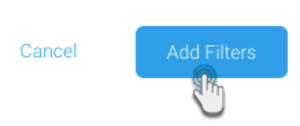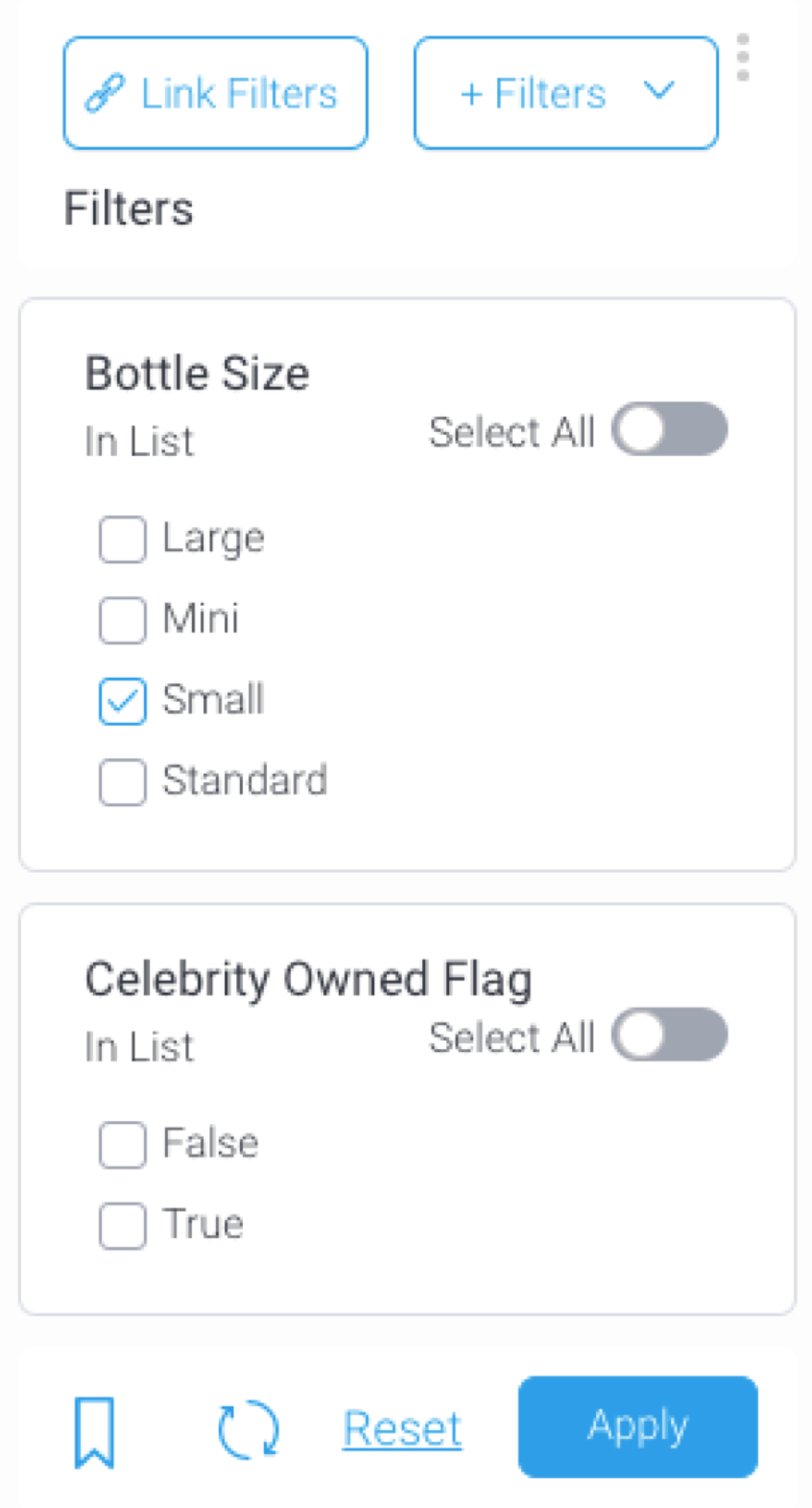Page History
...
- Click on the Filters icon on your dashboard builder to bring up the Filter Widget list.
- Then drag a Filter Widget onto the dashboard at the exact location you would like to display the filter. This includes anywhere on the dashboard canvas, or within any of the global content containers (essential for global filter lists).
- A filter panel will appear on the location it was dropped. (Side note: click here for an overview of this filter panel).
- Add report filters to this panel by clicking on the + Filters button.
- Choose Filter to add individual filters (you can add multiple as well), or Filter Group to add a filter group. (In our example, we will choose Filter.)
- A pop up displaying available report filters will appear. This allows you to choose which filters to add from any of the reports.
Note: The filters in this popup are categorized, first according to the dashboard sub tab, and then reports within the tab.
Note 2: If none of the reports contain any filters, then the following notification will appear on this popup. Click on the Add a report link to open the Reports tab on the left side. - Click on one or more filter checkboxes to select those that you want to add. Alternatively, enable the Select All toggle to select all the filters on this pop up. You can undo this selection by choosing the Clear All.
- Click on the Add Filters button on the bottom of this pop up to add the filters.
- The filters will then appear in the filter panel on the dashboard, as shown in the example below.
...
Filter
...
You can wire filters belonging to one report to other reports on the dashboard. This filter linking means that if a user applies a selected value to a user prompt filter, all linked reports will be updated according to that selected value. You can link filters automatically, or manually. Read the below sections for more information.
Note: before enabling filter linking, ensure you have added filters to your filter panel.
Filter linking involves creating links between a dashboard filter (that is, a filter added to a dashboard appearing in a filter panel; this is also referred to as the parent filter), and filters in other reports on the same dashboard (aka child filters).
Automatic linking
Automatic linking enables the system to automatically form links between a dashboard filter (or parent filter), and child filters of other reports.
If auto-linking is enabled, Yellowfin will create links between report filters that match (see rules on how they match below). This saves users the trouble of setting up links manually or applying any analytical report settings, as done in previous versions of Yellowfin. The system also notifies users when automatic linking has successfully taken place, or in case of a failure, informs of the reason it failed.
Automatic linking rules
An automatic linking match is successful if:
- The parent and child filters are from the same view.
- Both filters are the same ‘field’ (e.g. Company Name to Company Name).
- Both filters are not from the same report widget (however, you can add another version of the same report and link their filters)
...
Automatic links will not be created if:
- Either of the filters are parameters.
Note: parameters in a filter list can be manually linked to other parameters on the dashboard. - The child report has a subquery.
- The child filter on the dashboard is already linked to another filter.
Enable automatic linking
There are multiple ways to enable automatic linking:
...
Manual Linking
Users can also manually create links between filters of different dashboard reports. This is ideal if you want to link reports belonging to different views or data sets.
You have two methods to manually link:
- Link multiple filters through the Link Filters button on a filter panel.
- Alternatively, you may also link an individual filter by accessing its menu and using the Link To option.
Manual linking rules
Use these rules to successfully create a manual link:
- The parent and child filters must be of the same type (e.g. numeric).
- Both must have the same filter operator (e.g. In List).
- The child filter isn't already linked to. (A parent filter can be link multiple times.)
- The child filter isn’t added to another filter list.
Side notes:
- You can still create a manual link between filters of different types, however they will not update the child report correctly (thereby resulting in useless links).
- If the child report does not actually have a filter, you can still select a suitable data field. Yellowfin will create a background filter of the field and establish a link.
Tutorial: How to manually link filters
Here’s how to set this manual linking:
...
| Info |
|---|
If you selected a data field instead of an existing filter, and the field matches the ‘linking rules’, then Yellowfin will create this field into a filter in the background, permitting a manual link to be created. |
...
Filter Linking Progress
The system sends notifications on the success or failure of manual or automatic linking. If linking was created successfully, a success notification will appear on the bottom-right of the screen.
However, if it was a failure, the notification will inform the user of this, along with the reason for its failure. For example:
Filter properties
The filter properties panel lets you configure the following settings.
| Section | ||||||||||||||||||
|---|---|---|---|---|---|---|---|---|---|---|---|---|---|---|---|---|---|---|
|
Dashboard Filter Bookmarks
This functionality allows you to bookmark a filtered dashboard. This means that you can bookmark your dashboard after applying a combination of filter values and drill downs to it. Doing so saves you the trouble of having to reapply the same filter and drill combination each time you visit your dashboards. You can simply reload your dashboard with the preferred filters and drills upon selecting a Dashboard Filter Bookmark.
When creating a Dashboard Filter Bookmark, you can choose to make it publicly available for every dashboard user, or only specific user(s). Private bookmarks will only be seen by the user who created them, and the assigned dashboard users. They are identified with a lock icon next to them.
How to create a Dashboard Filter Bookmark
...
How to apply a saved bookmark
Here’s what to do to quickly refresh your dashboard by applying your bookmarked filter values.
...
Note:
...
|








